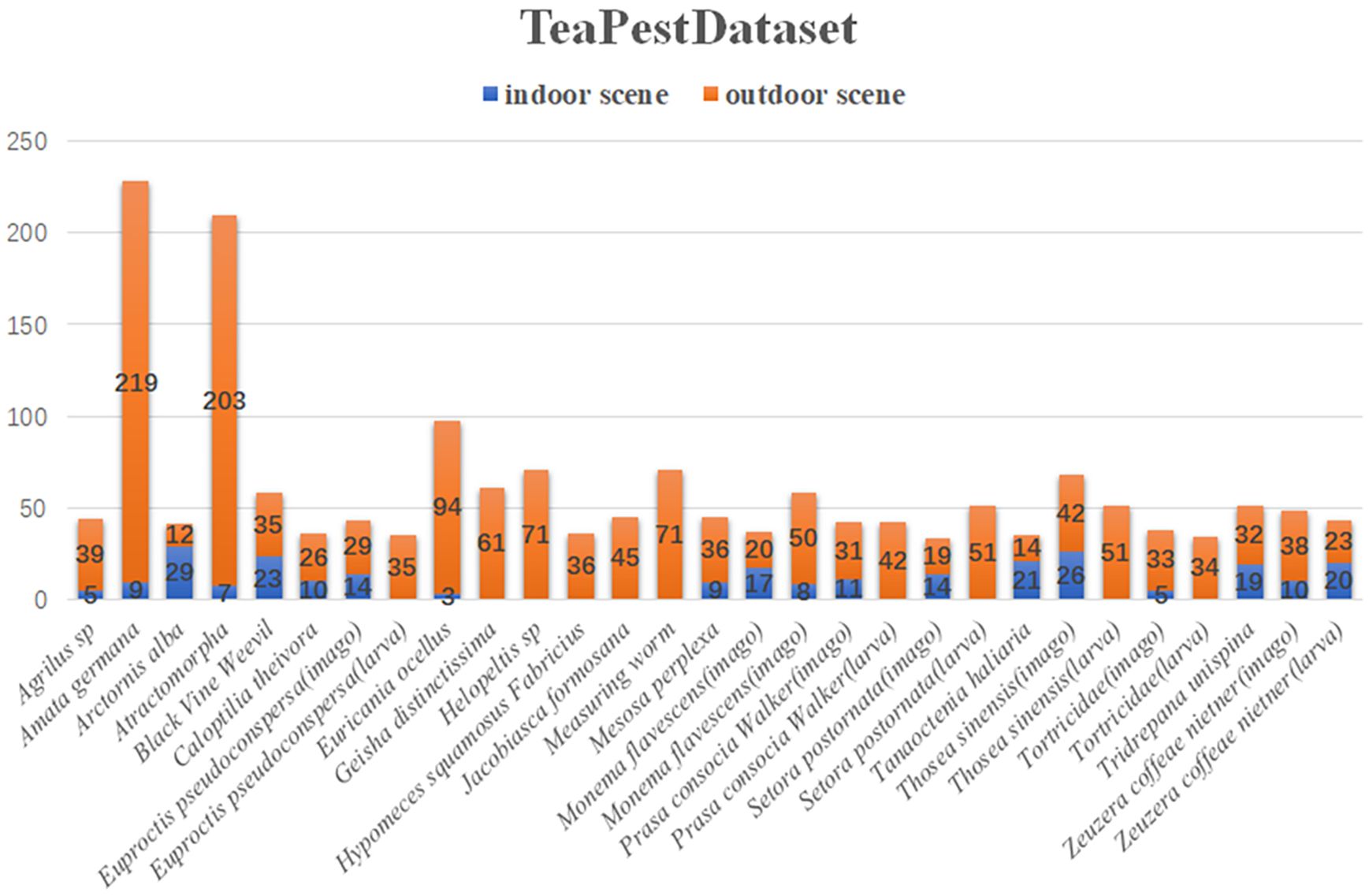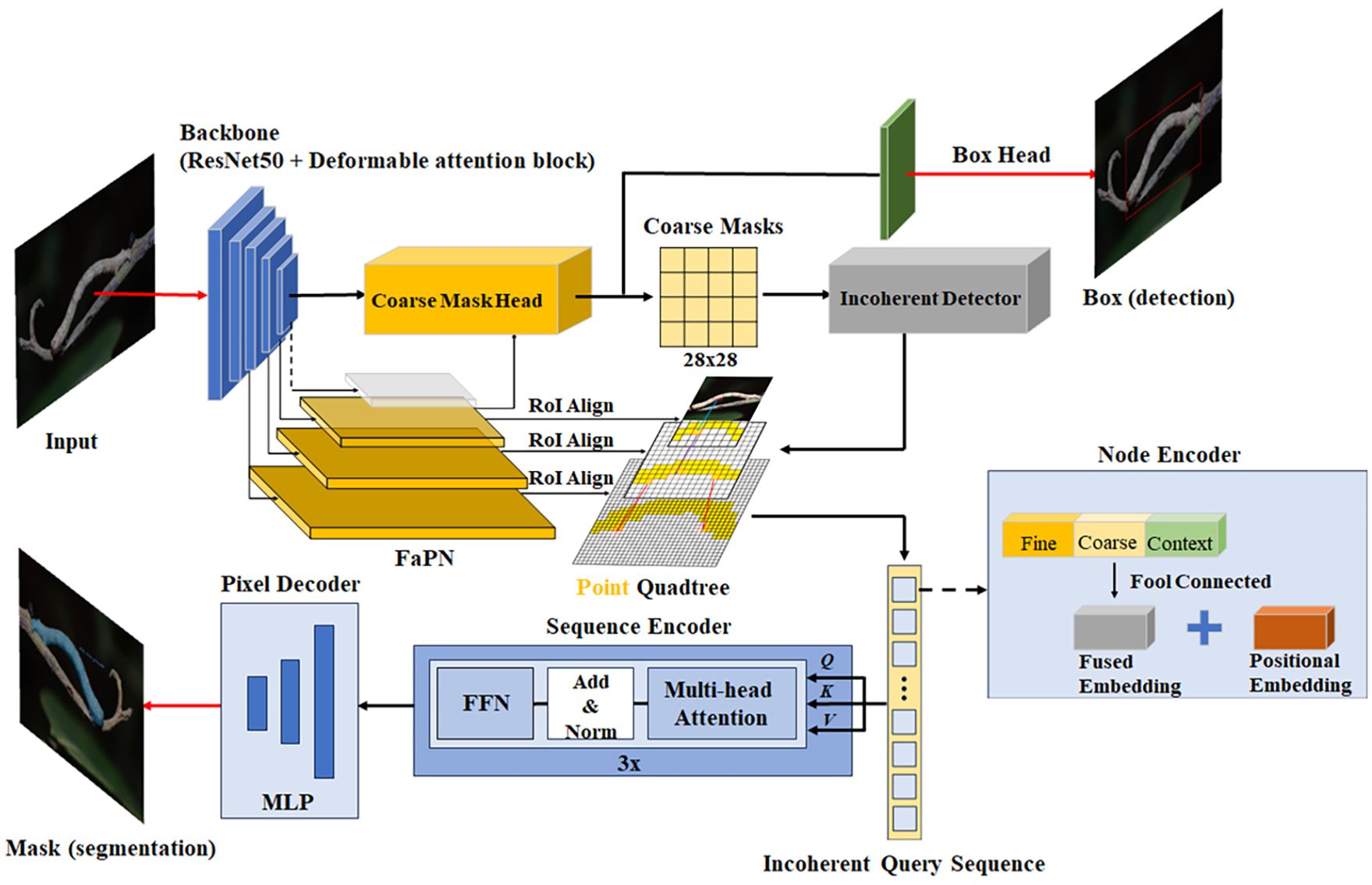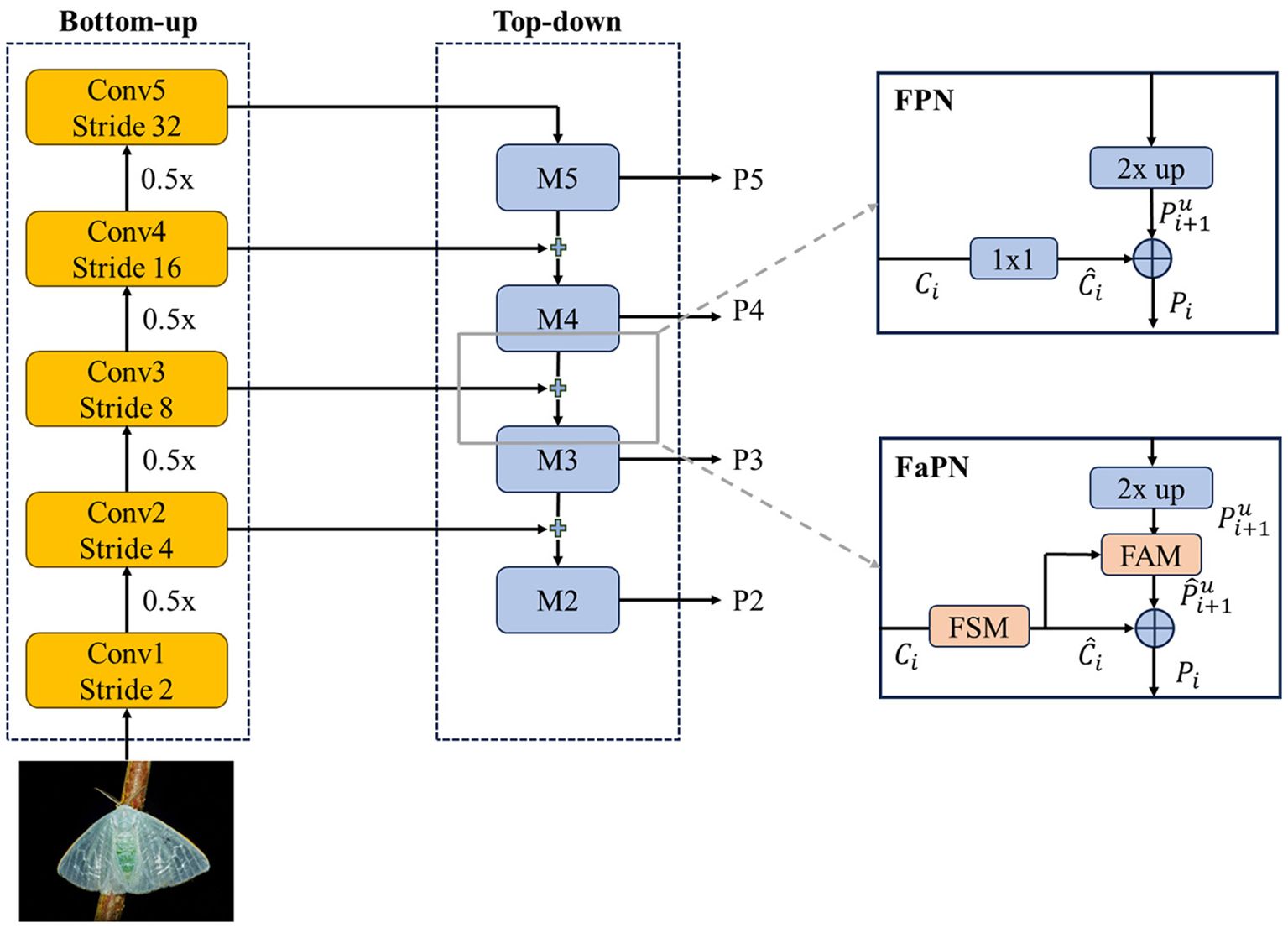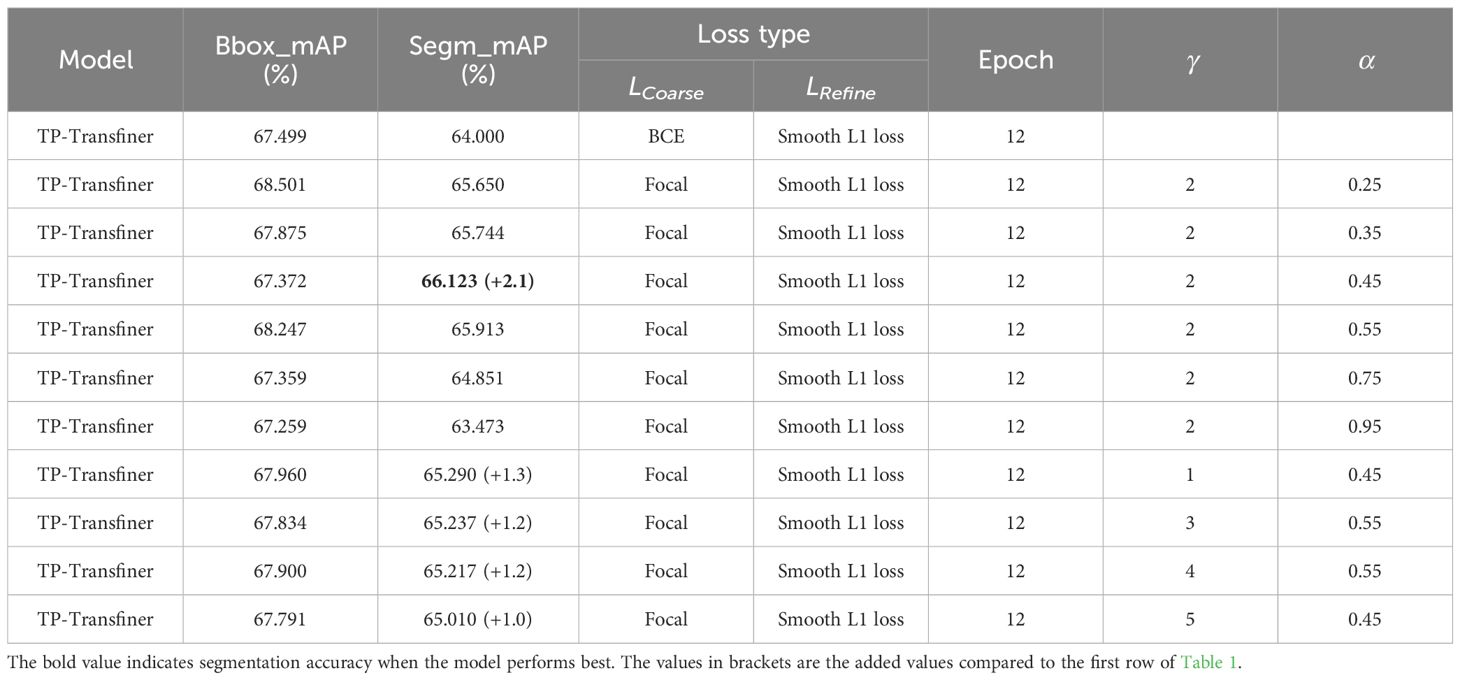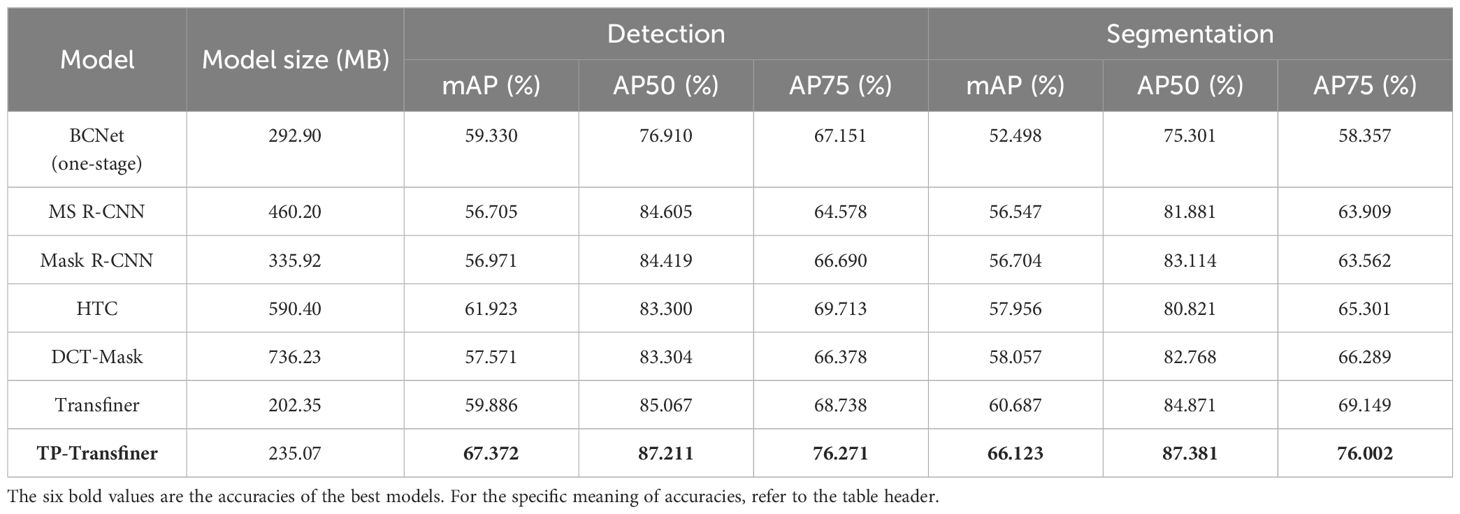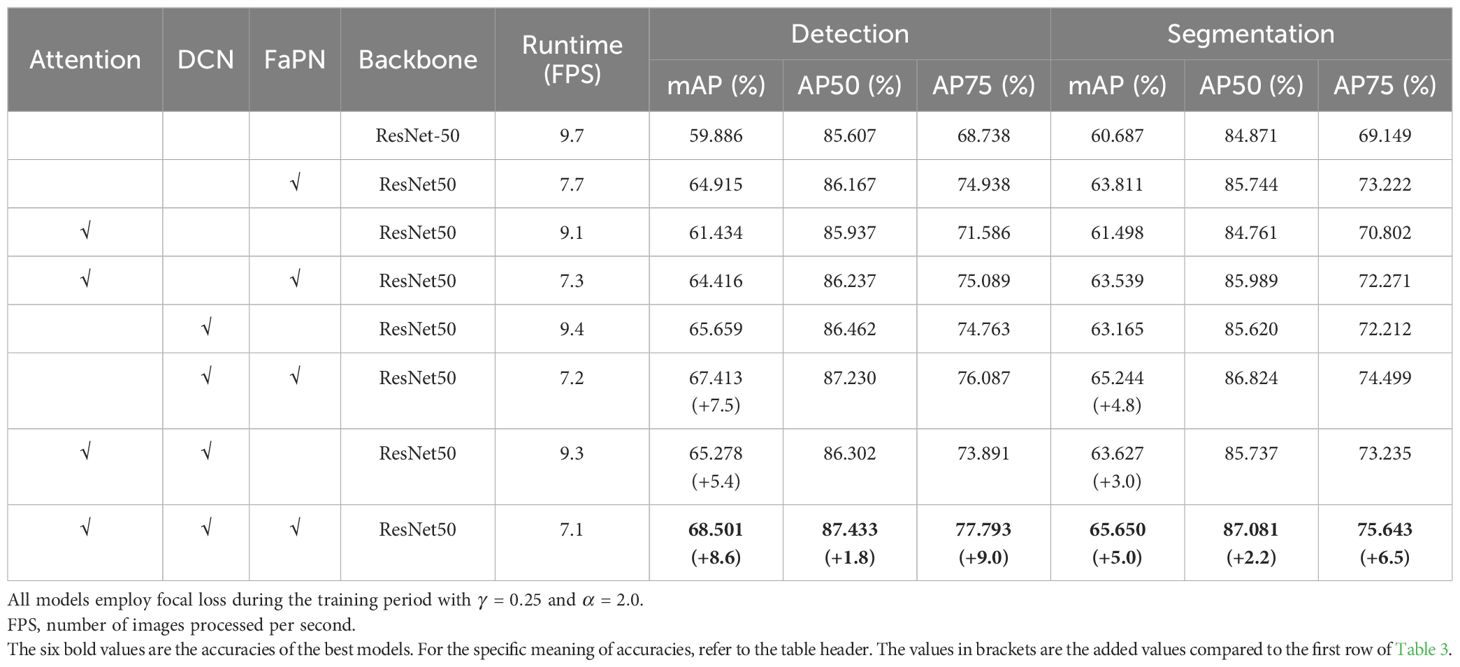- 1College of Informatics, Huazhong Agricultural University, Wuhan, China
- 2Engineering Research Center of Intelligent Technology for Agriculture, Ministry of Education, College of Informatics, Huazhong Agricultural University, Wuhan, China
- 3School of Computer Science, Wuhan University, Wuhan, China
- 4College of Plant Science & Technology, Huazhong Agricultural University, Wuhan, China
Detecting and controlling tea pests promptly are crucial for safeguarding tea production quality. Due to the insufficient feature extraction ability of traditional CNN-based methods, they face challenges such as inaccuracy and inefficiency of detecting pests in dense and mimicry scenarios. This study proposes an end-to-end tea pest detection and segmentation framework, TeaPest-Transfiner (TP-Transfiner), based on Mask Transfiner to address the challenge of detecting and segmenting pests in mimicry and dense scenarios. In order to improve the feature extraction inability and weak accuracy of traditional convolution modules, this study proposes three strategies. Firstly, a deformable attention block is integrated into the model, which consists of deformable convolution and self-attention using the key content only term. Secondly, the FPN architecture in the backbone network is improved with a more effective feature-aligned pyramid network (FaPN). Lastly, focal loss is employed to balance positive and negative samples during the training period, and parameters are adapted to the dataset distribution. Furthermore, to address the lack of tea pest images, a dataset called TeaPestDataset is constructed, which contains 1,752 images and 29 species of tea pests. Experimental results on the TeaPestDataset show that the proposed TP-Transfiner model achieves state-of-the-art performance compared with other models, attaining a detection precision (AP50) of 87.211% and segmentation performance of 87.381%. Notably, the model shows a significant improvement in segmentation average precision (mAP) by 9.4% and a reduction in model size by 30% compared to the state-of-the-art CNN-based model Mask R-CNN. Simultaneously, TP-Transfiner’s lightweight module fusion maintains fast inference speeds and a compact model size, demonstrating practical potential for pest control in tea gardens, especially in dense and mimicry scenarios.
1 Introduction
As a vital economic crop, tea faces annual challenges from various pests during its cultivation, significantly impacting productivity and quality. Major tea pests include Jacobiasca formosana, Geisha distinctissima, Arctornis alba, Measuring worm, Tortricida, Amata germana, and Euricania ocellus, among others. Throughout the evolution of some tea pests, their morphological characteristics often undergo significant changes (Ihsan-ul Haq et al., 2003), making it difficult to manually track pest dynamics. Additionally, the mimicry and dense distribution characteristics exhibited by some tea pests complicate their identification and localization. Consequently, these challenges have driven the development of artificial intelligence for pest monitoring.
Convolutional neural network (CNN) is a primary choice for image processing and is widely used in various fields of computer vision. Sharma et al. (2022); Yang et al. (2024), and Singh et al. (2022) conduct image recognition and classification tasks across different application fields by constructing CNNs with various architectures. These studies leverage the excellent feature extraction capabilities of CNN and demonstrate the superiority and robustness of their respective models through experiments.
As deep learning continues to revolutionize various domains, its application in plant monitoring has garnered significant attention, leading to innovative solutions and enhanced performance in plant disease and pest detection. Liu and Wang (2021) explore challenges in the practical application of deep learning for plant disease and pest detection. They propose potential solutions, presented research ideas to address these challenges, and offered insightful suggestions. Kaur et al. (2024) utilized the H-CSM model, which integrates support vector machine (SVM), convolutional neural network (CNN), and convolutional block attention module (CBAM) to detect and classify plant leaf diseases. Experimental results indicate a classification accuracy of 98.72%. Kang et al. (2023) introduce MCUNet, a corn leaf pest detection and segmentation model that outperforms mainstream neural networks. Furthermore, aiming to obtain a more lightweight model, Agarwal et al. (2023) propose a pest detection method utilizing the EfficientNetB3 model. Experimental results demonstrate the effectiveness in achieving high accuracy for classifying various pests in image datasets. Dai et al. (2023) introduce an improved YOLOv5m-based method for pest detection in plants. By integrating Swin-Transformer and Transformer mechanism, their approach improves the detection accuracy and efficiency. Besides this, Jiao et al. (2022); Tian et al. (2023), and Yang et al. (2023a) also utilized deep learning methods to detect and classify pests on various plants. In summary, these studies have predominantly relied on conventional detection methods for monitoring and has not performed segmentation of the detected pests or leaf diseases. By achieving high detection accuracy through the construction of pest datasets and model improvements, these studies effectively address challenges such as small targets, multiscale detection, and real-time requirements.
In contrast, the field of pest or leaf diseases monitoring in tea gardens remains relatively underexplored, with only a few studies focusing on tea pest monitoring (Wang et al., 2023; Yang et al., 2023b; Ye et al., 2024). These studies primarily concentrate on the detection of tea pests without further segmentation of individual pests. The complex distribution of pests in tea gardens, characterized by mimicry and dense populations, presents significant challenges for traditional pest detection models. As for tea pest monitoring, a previous work conducted by Zhou et al. (2021) uses automatic machine learning to classify each image in the TeaPestDataset. Xue et al. (2023); Yang et al. (2023b), and Lin et al. (2023) utilize the popular object detection model YOLO (Redmon et al., 2016) to detect tea plant diseases or pests. Hu et al. (2021) employ a discriminative pyramid network for semantic segmentation of tea geometrids in natural scenes. Experimental results demonstrate excellent performance in the semantic segmentation of tea geometrids. In contrast, this research treats each pest as an individual entity, achieving specific pest counts and improving edge processing capabilities by developing a deeper network for instance segmentation. Furthermore, this study not only accurately identifies both larva and adult tea geometrids but also encompasses the identification and processing of 27 other common pests in tea gardens. Moreover, Hu et al. (2024) employ hybrid architecture based on transformer to detect tea pests in complex backgrounds. However, previous researches on tea pest monitoring primarily focus on classification, detection, or semantic segmentation tasks, ignoring the importance of instance segmentation tasks for pest control. This study summarizes previous researches on tea pest detection and applies instance segmentation tasks to improve the effectiveness of tea pest control. Instance segmentation offers a promising solution to these issues by enabling pixel-wise parsing of pest images, thereby accurately predicting the position of each pest.
Additionally, in practical applications, traditional detection methods face significant limitations, particularly in scenarios involving target overlap and occlusion, leading to suboptimal detection performance. Moreover, precise pesticide application in tea gardens necessitates adjusting dosages based on pest size to balance effective pest control with environmental concerns. Various pests and disease pathogens exhibit different degrees of resistance to pesticides at various growth stages. Consequently, pesticides should ideally be applied during periods when pests are most susceptible. The results of segmentation tasks can provide detailed information on pest growth, development, and distribution, which is critical for precise pesticide application.
To address these limitations caused by detection models, recent studies committed to segmentation tasks have shown potential solutions. Classical two-stage segmentation models, such as Mask R-CNN (He et al., 2017), Mask Scoring R-CNN (Huang et al., 2019), HTC (Chen et al., 2019), and DCT-Mask (Shen et al., 2021) exhibit excellent segmentation performance. Besides this, one-stage models such as BCNet (Ke et al., 2021) and SOLO (Wang et al., 2021) also have superior performance and efficiency. However, these segmentation models may lack sensitivity to details and edge features, leading to unsatisfactory extraction results and aliasing. Mask Transfiner (Ke et al., 2022) incorporates Transformer architecture into the model to provide supervision and self-correction for regions erroneously predicted by Mask R-CNN. Built upon this innovative mechanism, the segmentation performance of the edge area is significantly optimized.
The attention mechanism is a crucial component in various algorithmic theories within the realm of computer vision. The integration of the attention module with the deep network enhances the network’s ability to better extract target features (Xu et al., 2021)—for instance, Wang et al. (2022) demonstrate the effectiveness of the attention module combined with D2Det in pest segmentation. Yang et al. (2023b) improve the YOLOv7-tiny model by utilizing deformable convolution and attention mechanism, achieving 93.23% accuracy on their self-made tea pest segmentation dataset. Additionally, Zhang and Huang (2022) design a novel attention mechanism to overcome challenges such as scale changes, complex backgrounds, and dense distribution in light trap images. Experimental results show that the model outperforms both classic detection models and lightweight detection models.
Besides this, the deformable convolutional network (DCN) (Dai et al., 2017) enhances feature extraction accuracy by employing deformable convolution kernels. A deep convolutional network combined with a deformable convolution structure is proposed by Cao et al. (2020) to overcome geometric transformations. Experiments have demonstrated that the framework, when fused with the DCN, effectively improves the accuracy as well as inference speed of object detection. Significant improvement has been observed in the trade-off between them.
In order to effectively solve the monitoring problems of tea pests in mimicry and dense scenarios, this study proposes a framework named TeaPest-Transfiner (TP-Transfiner) for tea pest detection and segmentation tasks using an enhanced Mask Transfiner framework. The main contributions are as follows:
● Provide a dataset including 1,752 tea pest images and corresponding annotated file, which can be used in the object detection and instance segmentation tasks.
● Fuse the attention mechanism into the backbone network and improve the FPN architecture of the Mask Transfiner to get a novel pest monitoring model TP-Transfiner.
● Implement experiments and demonstrate that while maintaining lightweight, TP-Transfiner outperforms classical models for tea pest detection and segmentation tasks, particularly in dense and mimicry scenarios.
2 Materials and methods
This section summarizes the datasets used in this study and the implementation details of the proposed TP-Transfiner model. Specifically, Section 2.1 discusses the collection, annotation, and data augmentation of the TeaPestDataset. Section 2.2 details the overall process and implementation of the TP-Transfiner model. Section 2.3 presents the evaluation metrics used in the experiments.
2.1 TeaPestDataset and data augmentation
To develop widely applicable pest detection and segmentation models, a carefully selected and labeled dataset is necessary. In this study, various types of pest images in diverse scenarios are collected and manually labeled, resulting in a total of 1,752 images. The original pictures in the dataset are primarily sourced through three methods. The first method involved images provided by agriculture and forestry-related laboratories and pictures pertaining to tea pest knowledge. The second method consisted of on-site shooting in tea gardens using mobile devices. The third source was from Internet search engines. Consequently, the collected scenes are mainly categorized into indoor (laboratory or specimen) and outdoor (natural environment of the tea garden) scenes. Specifically, there are 1,492 images of outdoor scenes and 260 images of indoor scenes. These images serve as the original dataset for tasks related to the localization and segmentation of pest instances.
Figure 1 presents samples of the dataset. The first row displays the original images, and the second row shows the annotated images. The dataset includes images and annotations of tea pests in mimicry and dense scenarios, providing a foundation for the model’s robust generalization performance in these complex scenes. During the dataset design process, 22 common pest species found in tea plantations are selected. However, considering the significant morphological differences during different growth stages of some pests, the larvae and adult stages of certain pests are further subdivided. Consequently, the final dataset comprises 29 categories, with the specific quantities of images in indoor and outdoor scenes for each type of pest illustrated in Figure 2.
The initial sample size is limited, and there is inconsistency in the number of various data types. This condition may lead to model overfitting, causing a tendency to predict categories with a higher number of samples. Hence, the original dataset is augmented to achieve a more uniform distribution of each data type. In addition to rotation and cropping, random affine transformations and random color transformations (including adjustments to image brightness, contrast, saturation, and hue) are applied to enhance the model’s generalization ability, as shown in Figure 3. Finally, the dataset in this study includes a total of 34,928 images across 29 categories. The process of making the dataset is to divide the 1,752 original images in a ratio of 7:2:1 and then perform data augmentation on the training set and validation set. To avoid falsely high precision, the test set remains the original images.
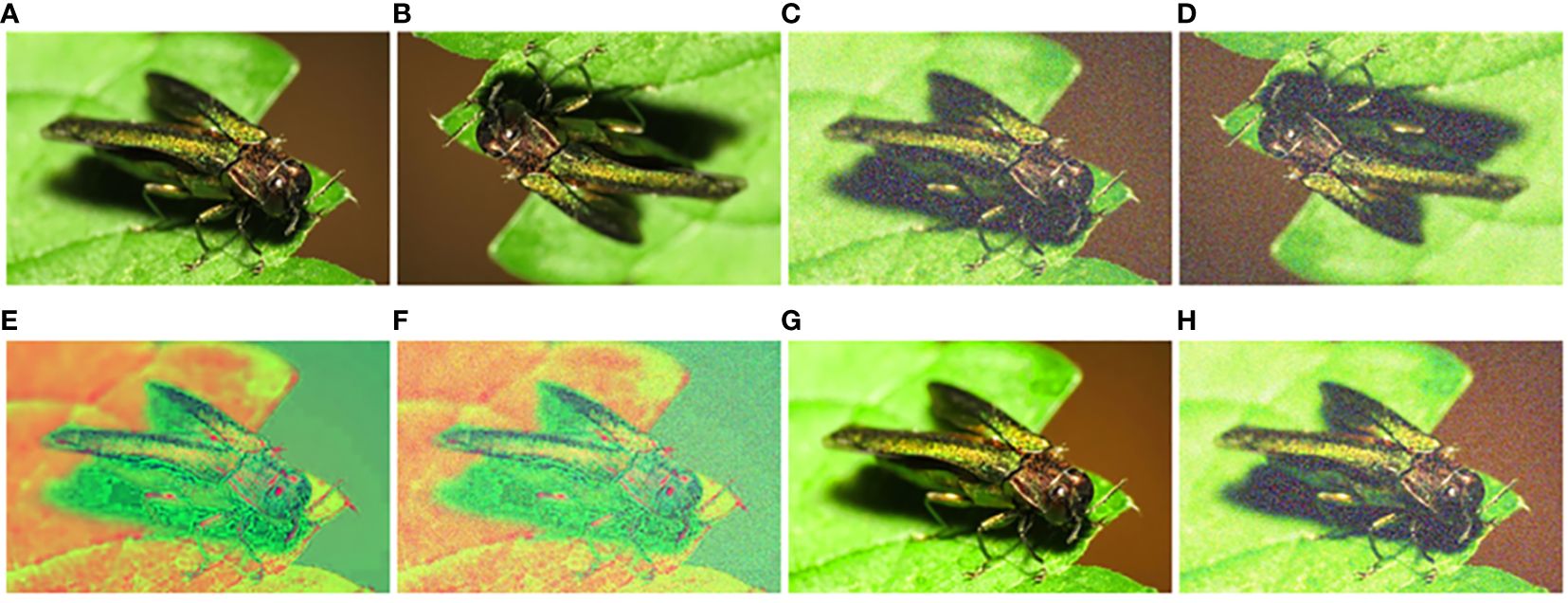
Figure 3. Examples of data augmentation. (A) Original, (B) flip, (C) noise adding, (D) flip and noise adding, (E) adjust hue 1, (F) adjust hue 2, (G) adjust saturation, and (H) adjust saturation and noise adding.
2.2 TeaPest-Transfiner
This study introduces an optimized framework—for instance, segmentation of tea pests based on Mask Transfiner. Primarily, it integrates the attention mechanism and DCN module into backbone network, replacing the backbone network in Mask Transfiner. Additionally, it utilizes the feature-aligned pyramid network (FaPN) (Huang et al., 2021) as a feature extraction module to segment the edge of each instance in high quality. Figure 4 depicts the network diagram of the optimized Mask Transfiner segmentation model, referred to as TP-Transfiner.
2.2.1 Backbone network
Most of the time, backbone network refers to the feature extraction network, and its function is to extract information from the image, which is then utilized by the box head and mask head. In this study, a ResNet fused with attention module and FaPN are combined as the backbone network of Mask Transfiner, which is used to extract features of pests.
2.2.1.1 ResNet
The ResNet is proposed by He et al. (2016), and it has been proven to effectively improve the accuracy and convergence of deep learning. A ResNet learns image data by its well-designed residual block (as shown in Figure 5A), which can be defined as Equations 1 and 2.
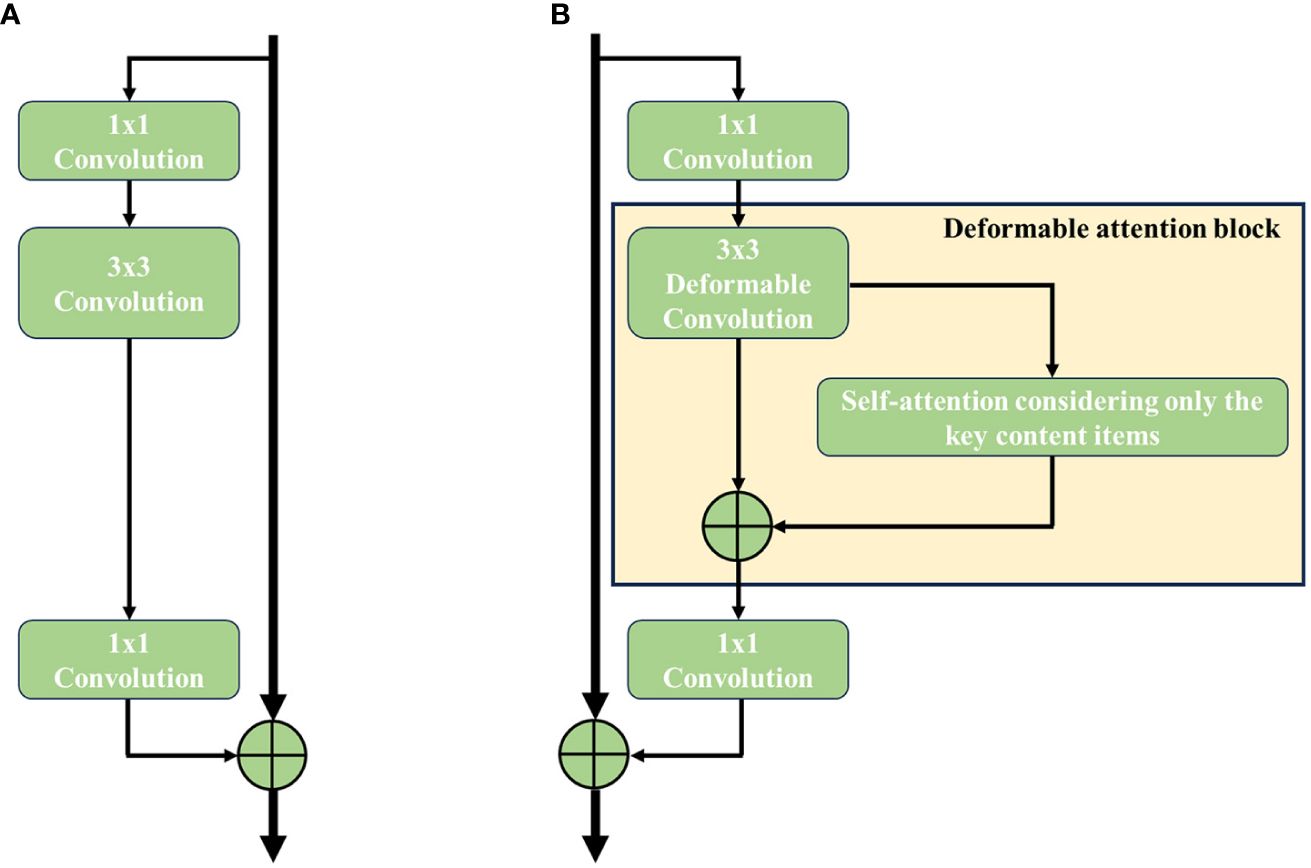
Figure 5. Structure comparison of residual block in ResNet-50. (A) Original residual block and (B) deformable attention block.
where F(x, {Wi}) denotes the residual mapping to be learned, and x is the input vector of previous layers or image. If the dimensions of x and F are not equal, a linear projection Ws can be applied to match the dimensions, as shown in formula 2.
According to the research of He et al. (2016), the experimental results illustrate that the residual block has the ability in solving problems such as gradient vanishing and training degradation of the deep network. ResNet has outstanding feature extraction performance without increasing the model parameters and computational burden. Therefore, ResNet is chosen as the backbone network. At the same time, to balance efficiency and accuracy, ResNet-50 is chosen.
2.2.1.2 Attention mechanism
The attention mechanism in deep learning draws inspiration from the attentional processes observed in human vision. Essentially, it comprises a set of weight parameters that can autonomously learn during the training period through the network. The mechanism prioritizes region of interest (RoI) in a dynamically weighted manner, simultaneously suppressing irrelevant background regions.
Dai et al. (2019) propose a solution to address the issue of context fragmentation by integrating the transformer attention module into the backbone network. Building upon this foundation, Zhu et al. (2019) conduct a comprehensive study that investigated the influence of four different factors: the query and key content, the query content and relative position, the key content only, and the relative position. Additionally, they explore the impact of incorporating deformable convolution into the network. Empirical results show that a proper combination of deformable convolution and the key content only term in transformer attention achieves the best accuracy–efficiency trade-off compared with the transformer attention module alone. Based on this conclusion, the key content self-attention module is integrated into the ResNet-50 backbone network in this study. Detailed information is indicated by Equation 3.
where um is a learnable vector. It captures salient key content which should be focused on the task and is irrelevant to the query. T represents the transpose of a vector, and m represents one of the attention heads. is learnable embedding matrices for the key content and xk denotes the input.
Specifically, the 3 × 3 regular convolution in the residual block is replaced with a deformable convolution block. Subsequently, a 3 × 3 deformable convolution in the residual block is followed by the addition of a self-attention module, contributing to the deformable attention block (as shown in Figure 5B). To apply a pre-trained model without altering its original behavior, the self-attention module is inserted using a residual connection. The output of the self-attention module is then multiplied by a learnable scalar initialized to zero. The residual block after the third stage of ResNet-50 is replaced with an optimized one, and the feature map outputted by ResNet-50 serves as the input for FaPN for multi-scale feature extraction.
2.2.1.3 FaPN
Achieving accurate mimetic pest instance detection requires the availability of both high-quality spatial information for precise object detection and robust semantic information for effective classification. FaPN optimizes FPN by replacing 1 × 1 convolutions with a feature selection module (FSM) and adding a feature alignment module (FAM) during upsampling, as shown in Figure 6. Inspired by SENet (Hu et al., 2018), FSM accurately extracts crucial information about features and recalibrates them by performing channel reduction and suppressing redundant feature maps. FSM can be represented by Equation 4.
Here z signifies the data obtained through global average pooling of the input feature map Ci, while fm(z) denotes the modeling of the importance of each feature map through a process involving a 1 × 1 convolution followed by a sigmoid activation on z.
FAM refines each sampling position within the convolution kernel by employing a learnable offset, thereby aligning the upsampled feature map with a set of feature maps. The feature map Ci-1 furnishes the spatial position to determine Pi, ensuring alignment with Ci-1. FAM can be explained by Equation 5:
where ∘ signifies the channel concatenation operation, f° denotes the learned offset, and Fa(·) represents the alignment function.
2.2.2 Segmentation algorithm
To avoid a large number of edge pixels being misclassified, Mask Transfiner considers not only the high-level semantics of the image but also the large-resolution deep feature maps. With these fusion features, Mask Transfiner gains better result than the classic framework for tea pest detection and segmentation tasks in dense and mimicry scenarios. Besides this, the bounding box used for the detection task is generated by the original Faster R-CNN (Ren et al., 2016).
The mask head of Transfiner employs a quadtree structure to represent discrete points at various levels, addressing the discrete distribution characteristics of information loss areas. It utilizes a segmentation network based on Transformer to predict the label of each tree node instance in discontinuous space. As shown in Figure 4, the network comprises three modules—node encoder, sequence encoder, and pixel decoder—which work together to convert discrete nodes into unordered pixel sequences and predict instance labels for each point.
2.2.3 Loss function
Based on the structures above, the entire Mask Transfiner framework can be trained in an end-to-end manner. As shown in Equation 6, a multi-task loss function is defined as:
Here LRefine signifies refinement with L1 loss between predicted labels for incoherent nodes and their ground-truth labels. In TP-Transfiner, LRefine is replaced with smooth L1 loss. Besides this, a binary cross-entropy loss LIncoherent is utilized for detecting incoherent regions. The detection loss, denoted as LDetect, encompasses both localization and classification losses derived from the base detector, exemplified by Faster R-CNN. Subsequently, LCoarse represents the loss attributed to the initial coarse segmentation prediction generated by Mask R-CNN. The weights λ1,2,3,4 are initially given as {1.0,1.0,1.0,0.5}, respectively.
To mitigate the challenge posed by mimetic and close contact instances, focal loss (Lin et al., 2017) is introduced to LCoarse during training. Focal loss is tailored to address class imbalance in object detection tasks, where background class pixels dominate. Traditional cross-entropy (CE) loss struggles with the surplus of background samples, hindering optimal learning for the minority foreground class. Similarly, the mimicry of tea pests requires TP-Transfiner model to pay more attention to instances camouflaged within the background during training.
2.2.3.1 Focal loss
Yao et al. (2022) utilize focal loss to train Mask R-CNN and Mask Scoring R-CNN for peach disease segmentation. Experimental results indicated that after parameter adjustment, focal loss not only enhances segmentation accuracy but also improves detection rate. Based on this conclusion, focal loss is introduced to LCoarse to enhance the performance of TP-Transfiner, and parameters are adjusted in the same way.
Focal loss introduces a modulating factor that down-weights the contribution of well-classified examples, focusing more on the hard-to-classify samples. The key idea is to assign lower weight to easily classified examples and higher weight to misclassified or challenging examples. Equation 7 shows detailed definition for focal loss.
Here pt represents the predicted probability of the true class, and γ is a focusing parameter initially defined. Notably, αi represents the category weight assigned to each sample, where samples belonging to the same category share identical weights.
2.3 Evaluation metric
This study primarily focuses on object detection and instance segmentation tasks. Mean average precision (mAP) serves as a commonly used evaluation metric in object detection. Araújo et al. (2019) and Hong et al. (2020) proposed that its corresponding index is the average of the average precision rate (mAP). This metric is calculated using the values of true positive (TP) and false positive (FP) to assess the detection and segmentation results. Equations 8 and 9) can be employed for calculation. The higher the two parameters are, the better the detection and segmentation results.
where TP, FP, and FN represent true positive, false positive, and false negative, respectively. AP is the average precision of pixels segmentation, and C is the number of segmentation categories. Furthermore, AP50 and AP75 in detection task represent mAP of Bbox when IoU is 0.5 and 0.75, respectively. Also, AP50 and AP75 in segmentation task represent mAP of mask when IoU is 0.5 and 0.75, respectively.
3 Results and discussion
This section summarizes all the experiments and related extended discussions conducted in this study to demonstrate the effectiveness of the TP-Transfiner model. Section 3.1 presents the hyperparameter settings and the training process of the model. Section 3.2 discusses the results of adjusting two parameters in focal loss. Section 3.3 compares the TP-Transfiner with state-of-the-art models. Section 3.4 details the ablation study of the model.
3.1 Implementation
The experiments in this paper are conducted in Linux environment of the CentOS system, utilizing Python 3.7 and the PyTorch 1.7.1 framework. Two NVIDIA Tesla V100 32 GB GPUs are employed for training. Stochastic gradient descent (SGD) with momentum is chosen as the optimization method during training, with a momentum parameter set to 0.9 and 1K constant warm-up iterations. Besides this, the initial learning rate is set to 0.01, with a weight decay factor of 0.0001. The batch size is 8, and the training process extends over 12 epochs. The learning rate is reduced to 0.1 times the original value after the 8th and 11th epochs, respectively. After each epoch, the model is validated on the validation set and the weights of the current model are saved. The Mask Transfiner encoder consists of three standard transformer layers. Each layer has four attention heads with feature dimension at 256. Furthermore, the improved Mask Transfiner is initialized using the original Mask R-CNN model pre-trained on the COCO dataset (Lin et al., 2014) to accelerate the training process. All experiments are conducted on Detectron2 (Wu et al., 2019).
3.2 Adaption of parameters
In the current study, focal loss is utilized with empirical values of γ = 2 and α = 0.25. However, it is noted that different data distributions may require different parameters. Therefore, various values of γ and α are tested to accommodate these variations. As shown in Table 1, the implementation of focal loss enhances the overall accuracy of TP-Transfiner, with BCE loss resulting in the lowest accuracy. For each γ, the optimal α is determined to fit the dataset. As α increases, the weight of difficult samples increases, but excessively large α values can decrease the accuracy of the model. Table 1 demonstrates that the experimental results align well with these observations. The table only displays detailed results when γ = 2. For γ = 1,3,4,5, only the optimal results are shown. After multiple rounds of testing, the model achieves the best result on the validation set when γ = 2 and α = 0.45. As a result, focal loss improves the overall segmentation accuracy by 2.1%.
To illustrate the optimization achieved with focal loss, the accuracy on the validation set and changes in loss during the training period are depicted. Figure 7A presents the validation mAP of bounding boxes (IoU = 0.5) from epoch 1 to epoch 12 when training the dataset with different loss functions, indicating that the validation mAP of bounding boxes is higher with focal loss compared to BCE loss. Figure 7B shows the validation mAP of segmentation (IoU = 0.5) over the same epochs when trained with different loss functions, similarly demonstrating that the mAP of segmentation is higher with focal loss. Figure 7C illustrates the trend of training loss under different loss functions. It is evident that focal loss effectively reduces the loss during the training period compared to BCE loss, making the model more suitable for the distribution of the dataset. The results shown in Figure 7 and Table 1 indicate that the application of TP-Transfiner with focal loss achieves superior performance compared to BCE loss.
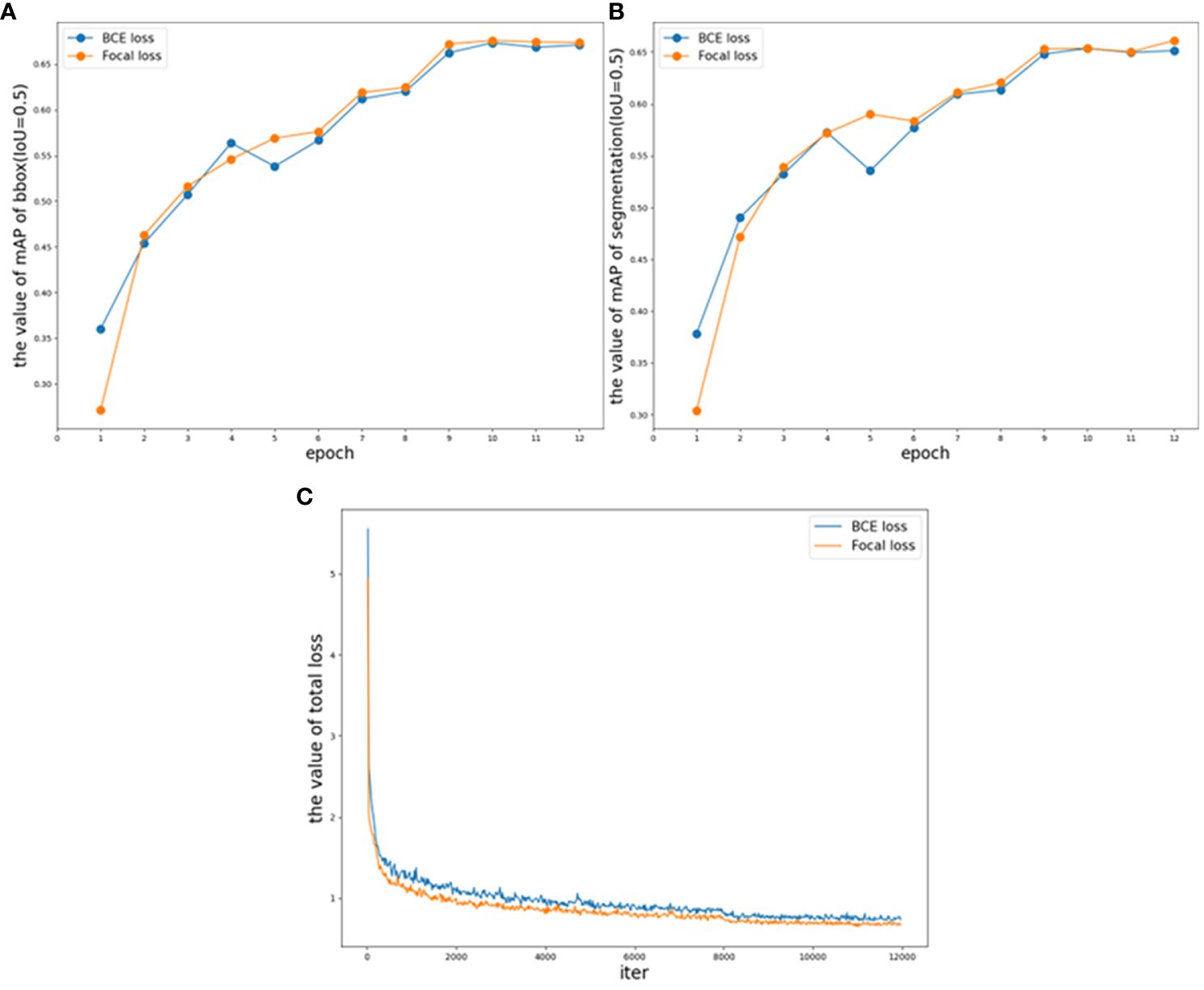
Figure 7. TP-Transfiner with different loss validation parameters and loss functions. (A) Comparison of mAP of bbox (IoU = 0.5) on different loss, (B) comparison of mAP of segmentation (IoU = 0.5) on different loss, and (C) comparison of total loss.
3.3 Comparison to state-of-the-art models
Detecting and segmenting pests in mimicry and dense scenarios poses a formidable challenge in tea production industry. The proposed TP-Transfiner model demonstrates excellent performance in addressing the detection and segmentation tasks especially in dense and mimicry scenarios. As illustrated in Figures 8A–H, conventional models such as BCNet, Mask R-CNN, Mask Scoring R-CNN, DCT-Mask, and HTC struggle to precisely segment intricate parts like antennae. Similarly, Mask Transfiner encounters difficulty in effectively capturing detailed features. In contrast, TP-Transfiner exhibits outstanding performance in accurately detecting and segmenting pests with detailed characteristics.

Figure 8. Comparison of segmentation results of different state-of-the-art models for tea pests with detailed and mimetic feature. (A–H) Arctornis alba, (I–P) Mesosa perplexa, and (Q–X) Measuring worm.
3.3.1 Performance in mimicry scenarios
Some tea pests like Measuring worm and Mesosa perplexa are very good at using the surrounding environment to disguise themselves. This phenomenon, called mimicry, greatly increases the difficulty of the neural network to detect tea pests. Through superior edge feature extraction ability, TP-Transfiner demonstrates excellent performance in detecting and segmenting mimetic pests. In Figures 8I–P, though various models segment the pest camouflaged in leaves, TP-Transfiner distinguishes itself by segmenting the detailed antennae and small body. Besides this, as shown in Figures 8Q–X, BCNet, Mask R-CNN, Mask Scoring R-CNN, DCT-Mask, and HTC all misidentify branches as pests. The original Mask Transfiner slightly improved the situation, while TP-Transfiner improves the segmentation of the mimetic pest very well. As a result, the proposed TP-Transfiner can effectively detect and segment the specific contours of tea pests in such scenarios.
3.3.2 Performance in dense scenarios
In the dense scenario depicted in Figure 9, the segmentation results of TP-Transfiner significantly outperforms other models. Though some models fail to segment two instances in contact (BCNet, Mask R-CNN, and Mask Scoring R-CNN) or segment overlapping objects, TP-Transfiner performs well. Additionally, TP-Transfiner demonstrates powerful ability in detail processing. Compared to other models, the mask predicted by TP-Transfiner comprehensively covers the entire detected pests, while BCNet, Mask R-CNN, Mask Scoring R-CNN, HTC, DCT-Mask, and Mask Transfiner retains a large number of unpredicted pixels belonging to pests. Overall, TP-Transfiner demonstrates superior edge feature extraction ability compared with other models, enabling accurate detection and segmentation of tea pests in dense distribution.
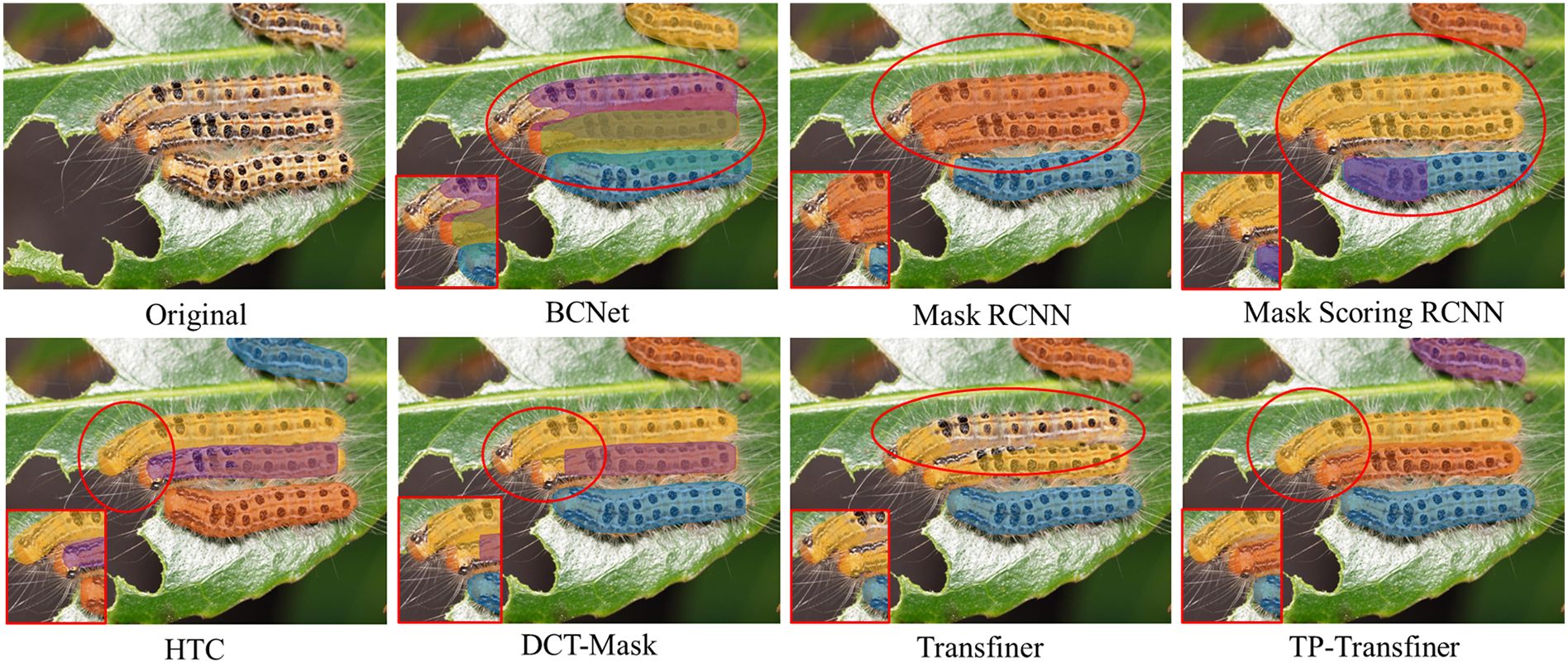
Figure 9. Comparison of segmentation results of different state-of-the-art models for tea pests (Euproctis pseudoconspersa) in dense scenarios.
Besides this, this study compares the detection and segmentation accuracy of seven state-of-the-art models including BCNet, Mask R-CNN, Mask Scoring R-CNN, HTC, DCT-Mask, Mask Transfiner, and TP-Transfiner. The results are shown in Table 2. Compared with BCNet, Mask R-CNN, Mask Scoring R-CNN, DCT-Mask, and HTC, the original Transfiner has obvious advantages in instance segmentation, and BCNet and HTC have higher accuracy in object detection task. Subsequently, the study optimizes the Transfiner by integrating deformable convolution, attention mechanism, and FaPN, resulting in the TP-Transfiner. Comparative analysis reveals that TP-Transfiner outperforms other methods, achieving the highest detection accuracy (mAP) of 67.372% and segmentation accuracy (mAP) of 66.123% for object detection and instance segmentation tasks. As for the light weight of the model, TP-Transfiner has a more significant advantage than other segmentation framework (except the original Transfiner). It denotes that TP-Transfiner holds broader application prospects in tea gardens with limited hardware equipment.
3.4 Ablation study
3.4.1 Impact of deformable attention block
To evaluate the feature extraction ability of the deformable attention block on transparent wings, slender antennae, and legs of tea pests, detailed comparative experiments are conducted. Figure 10 illustrates the segmentation effects of two different modules on pests with varying characteristics. It is evident that the model integrating the deformable attention block significantly improves the detection and segmentation effect of pest antennae (A, B), transparent wings (B, C), and mimicry scenario (D). The results demonstrate the deformable attention block’s exceptional feature extraction ability for pest’s edges and transparent states. The impact of the deformable attention block on detection and segmentation accuracy will be illustrated in the next section.
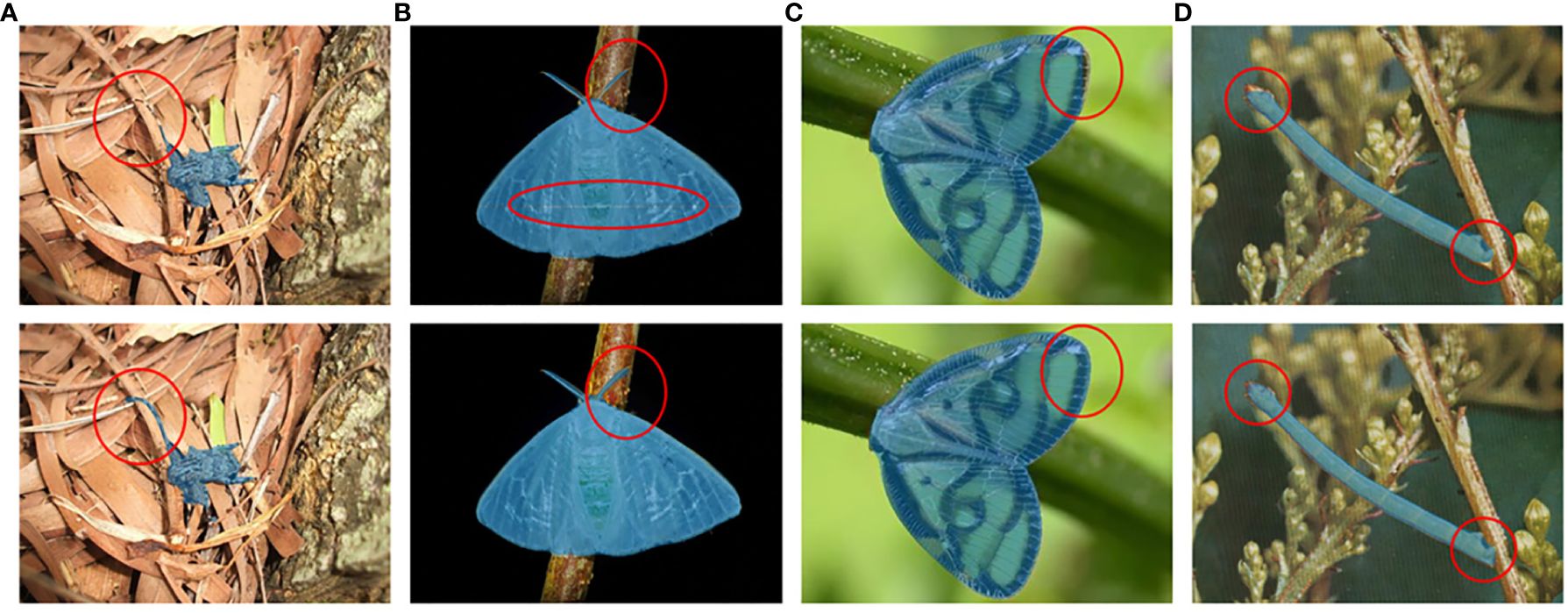
Figure 10. Comparison of segmentation results before (the first row) and after (the second row) integrating the deformable attention block. (A) Mesosa perplexa, (B) Arctornis alba, (C) Euricania ocellus, and (D) Measuring worm.
3.4.2 Effect of different modules
Table 3 illustrates that the integration of various modules into the Transfiner framework yields distinct accuracy improvements, with a more pronounced enhancement observed upon combining three modules. Compared with Transfiner, the proposed TP-Transfiner model improves the object detection accuracy (mAP) by 8.6% and the segmentation accuracy (mAP) by 5%. In addition, the fusion of modules does not affect the inference speed on images.
3.4.2.1 Effect of DCN
DCN learns by updating the offset, allowing the convolution kernel to align more closely with the shape and size of the object during sampling. This approach proves to be efficient for segmenting densely distributed and mimetic tea pests. Experimental results show that employing DCN enhances the accuracy of Transfiner, either integrating self-attention and FaPN or not, in both tea pest detection and segmentation tasks. Besides this, the integration of DCN refines the edge feature extraction results to detailed areas such as the insect’s antennae and legs, as shown in the feature extraction visualization outputted by the pyramid network (Figure 11).
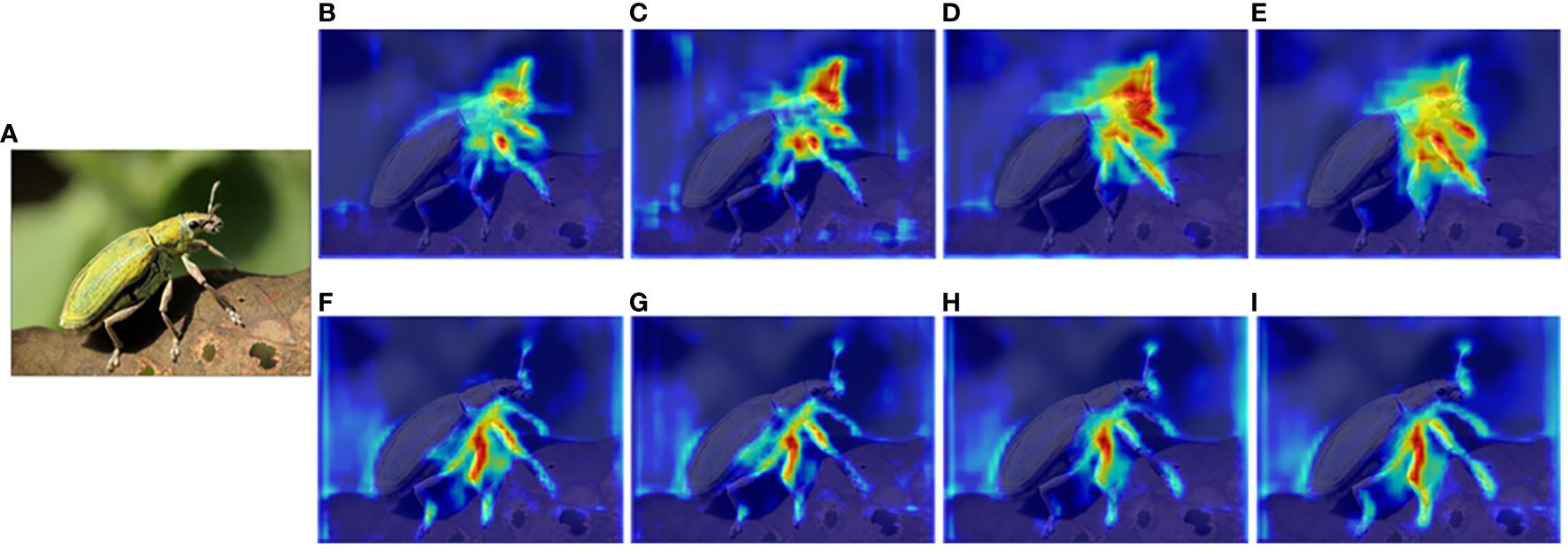
Figure 11. Visualization results of feature extraction after the backbone network fuses different modules. (A) Input, (B) FPN, (C) FPN fused with self-attention, (D) FPN fused with DCN, (E) FPN fused with DCN and self-attention (deformable attention block), (F) FaPN, (G) FaPN fused with self-attention, (H) FaPN fused with DCN, and (I) FaPN fused with DCN and self-attention (deformable attention block).
3.4.2.2 Effect of self-attention
As an essential component of the Transformer architecture, the module aims to extract global features from input images. As shown in Table 3, it can be observed that before integrating DCN, the fusion of this attention module leads to a decrease in the model’s detection and segmentation performance. However, incorporating DCN with self-attention (the deformable attention block) into the backbone results in a subtle improvement on detection and segmentation accuracy. It is noteworthy that while self-attention does not significantly improve accuracy, it enables the backbone network to focus more on detailed information such as the legs and antenna of pests, as shown in Figure 11. This mechanism has a significant impact on the TP-Transfiner’s ability to segment mimetic pest with slender antennae.
3.4.2.3 Effect of feature-aligned pyramid network
FaPN improves the feature misalignment issue of FPN, particularly around the border area. Therefore, it assists TP-Transfiner in enhancing the feature extraction ability for pest edge, leading to more accurate segmentation of pests in mimicry. A strong comparison depicted in the feature extraction visualization (Figure 11) shows that when FaPN is fused (the second line), the most attended area is distributed around the legs and antennae of the pest. As for the detection and segmentation accuracy, FaPN significantly improves model performance, regardless of whether the self-attention and DCN modules are integrated (as shown in Table 3).
4 Conclusion
To address the limitations of tea pest detection and segmentation in dense and mimicry scenarios, this study develops an end-to-end framework called TP-Transfiner. The framework integrates a deformable attention block, consisting of deformable convolution and a self-attention module, to improve pest feature extraction ability. Additionally, the FPN architecture is enhanced with a more effective FaPN to address feature misalignment issues. Focal loss is introduced during the training period, and and are adjusted to optimize the model’s performance. Furthermore, to solve the insufficient tea pest dataset for detection and segmentation tasks, this study conducts a TeaPestDataset including 29 categories of tea pests. Experimental results on the TeaPestDataset demonstrate that TP-Transfiner has outstanding tea pest detection and segmentation performance compared with several classic models, particularly in dense and mimicry scenarios. The model achieves state-of-the-art performance in both object detection (mAP: 67.372%) and instance segmentation (mAP: 66.123%) tasks, with the same computing resource requirements as the original model while remaining lightweight. Besides this, the deformable attention block is proven to have outstanding feature extraction ability on detailed information.
However, the proposed TP-Transfiner needs to be further improved for pest detection and segmentation in occluded scenes, and it is inefficient for the accurate detection of pests in real-time applications. Therefore, future work will focus on simplifying the model’s architecture. Additionally, this study plans to expand the variety and quantity of images in TeaPestDataset. These efforts aim to provide a more precise method for automating pest monitoring.
Data availability statement
The raw data supporting the conclusions of this article will be made available by the authors, without undue reservation.
Author contributions
RW: Writing – original draft, Conceptualization, Formal analysis, Methodology, Software, Visualization, Writing – review & editing. FH: Writing – review & editing, Supervision, Validation. ZR: Supervision, Validation, Writing – review & editing. ZL: Supervision, Validation, Writing – review & editing. WX: Supervision, Writing – review & editing, Investigation, Resources. FN: Data curation, Project administration, Resources, Writing – review & editing. WD: Supervision, Validation, Writing – review & editing.
Funding
The author(s) declare financial support was received for the research, authorship, and/or publication of this article. This work was supported by the Fundamental Research Funds for the Central Universities, Huazhong Agricultural University (grant number: 2662022JC005).
Conflict of interest
The authors declare that the research was conducted in the absence of any commercial or financial relationships that could be construed as a potential conflict of interest.
Publisher’s note
All claims expressed in this article are solely those of the authors and do not necessarily represent those of their affiliated organizations, or those of the publisher, the editors and the reviewers. Any product that may be evaluated in this article, or claim that may be made by its manufacturer, is not guaranteed or endorsed by the publisher.
References
Agarwal, A., Vats, S., Agarwal, R., Ratra, A., Sharma, V., Jain, A. (2023). “Efficient netb3 for automated pest detection in agriculture,” in 2023 10th International Conference on Computing for Sustainable Global Development (INDIACom). 1408–1413 (New York, America: IEEE).
Araújo, F. H., Silva, R. R., Ushizima, D. M., Rezende, M. T., Carneiro, C. M., Bianchi, A. G. C., et al. (2019). Deep learning for cell image segmentation and ranking. Computerized. Med. Imaging Graphics 72, 13–21. doi: 10.1016/j.compmedimag.2019.01.003
Cao, D., Chen, Z., Gao, L. (2020). An improved object detection algorithm based on multi-scaled and deformable convolutional neural networks. Human-centric. Computing. Inf. Sci. 10, 1–22. doi: 10.1186/s13673-020-00219-9
Chen, K., Pang, J., Wang, J., Xiong, Y., Li, X., Sun, S., et al. (2019). “Hybrid task cascade for instance segmentation,” in Proceedings of the IEEE/CVF conference on computer vision and pattern recognition. (New York, USA: IEEE) 4974–4983.
Dai, J., Qi, H., Xiong, Y., Li, Y., Zhang, G., Hu, H., et al. (2017). “Deformable convolutional networks,” in Proceedings of the IEEE international conference on computer vision. (New York, USA: IEEE) 764–773.
Dai, M., Dorjoy, M. M. H., Miao, H., Zhang, S. (2023). A new pest detection method based on improved yolov5m. Insects 14, 54. doi: 10.3390/insects14010054
Dai, Z., Yang, Z., Yang, Y., Carbonell, J. G., Le, Q., Salakhutdinov, R. (2019). “Transformer-xl: Attentive language models beyond a fixed-length context,” in Proceedings of the 57th Annual Meeting of the Association for Computational Linguistics. (Cambridge, Massachusetts, USA: MIT) 2978–2988.
He, K., Gkioxari, G., Dollár, P., Girshick, R. (2017). “Mask r-cnn,” in Proceedings of the IEEE international conference on computer vision. (New York, USA: IEEE) 2961–2969.
He, K., Zhang, X., Ren, S., Sun, J. (2016). “Deep residual learning for image recognition,” in Proceedings of the IEEE conference on computer vision and pattern recognition. (New York, USA: IEEE) 770–778.
Hong, S.-J., Kim, S.-Y., Kim, E., Lee, C.-H., Lee, J.-S., Lee, D.-S., et al. (2020). Moth detection from pheromone trap images using deep learning object detectors. Agriculture 10, 170. doi: 10.3390/agriculture10050170
Hu, G., Li, S., Wan, M., Bao, W. (2021). Semantic segmentation of tea geometrid in natural scene images using discriminative pyramid network. Appl. Soft. Computing. 113, 107984. doi: 10.1016/j.asoc.2021.107984
Hu, J., Shen, L., Sun, G. (2018). “Squeeze-and-excitation networks,” in Proceedings of the IEEE conference on computer vision and pattern recognition. (New York, USA: IEEE) 7132–7141.
Hu, X., Li, X., Huang, Z., Chen, Q., Lin, S. (2024). Detecting tea tree pests in complex backgrounds using a hybrid architecture guided by transformers and multi-scale attention mechanism. J. Sci. Food Agric. 104, 3570–3584. doi: 10.1002/jsfa.13241
Huang, S., Lu, Z., Cheng, R., He, C. (2021). “Fapn: Feature-aligned pyramid network for dense image prediction,” in Proceedings of the IEEE/CVF international conference on computer vision. (New York, USA: IEEE) 864–873.
Huang, Z., Huang, L., Gong, Y., Huang, C., Wang, X. (2019). “Mask scoring r-cnn,” in Proceedings of the IEEE/CVF conference on computer vision and pattern recognition. (New York, USA: IEEE) 6409–6418.
Ihsan-ul Haq, M. A., Kakakhel, S., Khokhar, M. (2003). Morphological and physiological parameters of soybean resistance to insect pests. Asian J. Plant Sci. 2, 202–204. doi: 10.3923/ajps.2003.202.204
Jiao, L., Xie, C., Chen, P., Du, J., Li, R., Zhang, J. (2022). Adaptive feature fusion pyramid network for multi-classes agricultural pest detection. Comput. Electron. Agric. 195, 106827. doi: 10.1016/j.compag.2022.106827
Kang, C., Wang, R., Liu, Z., Jiao, L., Dong, S., Zhang, L., et al. (2023). “Mcunet: Multidimensional cognition unet for multi-class maize pest image segmentation,” in 2023 2nd International Conference on Robotics, Artificial Intelligence and Intelligent Control (RAIIC). 340–346 (New York, USA: IEEE).
Kaur, P., Mishra, A. M., Goyal, N., Gupta, S. K., Shankar, A., Viriyasitavat, W. (2024). A novel hybrid cnn methodology for automated leaf disease detection and classification. Expert Syst. 41, e13543. doi: 10.1111/exsy.13543
Ke, L., Danelljan, M., Li, X., Tai, Y.-W., Tang, C.-K., Yu, F. (2022). “Mask transfiner for high-quality instance segmentation,” in Proceedings of the IEEE/CVF conference on computer vision and pattern recognition. (New York, USA: IEEE) 4412–4421.
Ke, L., Tai, Y.-W., Tang, C.-K. (2021). “Deep occlusion-aware instance segmentation with overlapping bilayers,” in Proceedings of the IEEE/CVF conference on computer vision and pattern recognition. (New York, USA: IEEE) 4019–4028.
Lin, J., Bai, D., Xu, R., Lin, H. (2023). TSBA-YOLO: An improved tea diseases detection model based on attention mechanisms and feature fusion. Forests 14, 619. doi: 10.3390/f14030619
Lin, T.-Y., Goyal, P., Girshick, R., He, K., Dollár, P. (2017). “Focal loss for dense object detection,” in Proceedings of the IEEE international conference on computer vision. (New York, USA: IEEE) 2980–2988.
Lin, T.-Y., Maire, M., Belongie, S., Hays, J., Perona, P., Ramanan, D., et al. (2014). “Microsoft coco: Common objects in context,” in Computer Vision–ECCV 2014: 13th European Conference, Zurich, Switzerland, September 6-12, 2014, Proceedings, Part V 13. 740–755 (Berlin, German: Springer).
Liu, J., Wang, X. (2021). Plant diseases and pests detection based on deep learning: a review. Plant Methods 17, 1–18. doi: 10.1186/s13007-021-00722-9
Redmon, J., Divvala, S., Girshick, R., Farhadi, A. (2016). “You only look once: Unified, real-time object detection,” in Proceedings of the IEEE conference on computer vision and pattern recognition. (New York, USA: IEEE) 779–788.
Ren, S., He, K., Girshick, R., Sun, J. (2016). Faster r-cnn: Towards real-time object detection with region proposal networks. IEEE Trans. Pattern Anal. Mach. Intell. 39, 1137–1149. doi: 10.1109/TPAMI.2016.2577031
Sharma, N., Gupta, S., Mohamed, H. G., Anand, D., Mazón, J. L. V., Gupta, D., et al. (2022). Siamese convolutional neural network-based twin structure model for independent offline signature verification. Sustainability 14, 11484. doi: 10.3390/su141811484
Shen, X., Yang, J., Wei, C., Deng, B., Huang, J., Hua, X.-S., et al. (2021). “Dct-mask: Discrete cosine transform mask representation for instance segmentation,” in Proceedings of the IEEE/CVF conference on computer vision and pattern recognition. (New York, USA: IEEE) 8720–8729.
Singh, T. P., Gupta, S., Garg, M., Gupta, D., Alharbi, A., Alyami, H., et al. (2022). Visualization of customized convolutional neural network for natural language recognition. Sensors 22, 2881. doi: 10.3390/s22082881
Tian, Y., Wang, S., Li, E., Yang, G., Liang, Z., Tan, M. (2023). Md-yolo: Multi-scale dense yolo for small target pest detection. Comput. Electron. Agric. 213, 108233. doi: 10.1016/j.compag.2023.108233
Wang, H., Li, Y., Dang, L. M., Moon, H. (2022). An efficient attention module for instance segmentation network in pest monitoring. Comput. Electron. Agric. 195, 106853. doi: 10.1016/j.compag.2022.106853
Wang, X., Zhang, R., Shen, C., Kong, T., Li, L. (2021). Solo: A simple framework for instance segmentation. IEEE Trans. Pattern Anal. Mach. Intell. 44, 8587–8601. doi: 10.1109/TPAMI.2021.3111116
Wang, Y., Xu, R., Bai, D., Lin, H. (2023). Integrated learning-based pest and disease detection method for tea leaves. Forests 14, 1012. doi: 10.3390/f14051012
Wu, Y., Kirillov, A., Massa, F., Lo, W.-Y., Girshick, R. (2019). Detectron2. Available online at: https://github.com/facebookresearch/detectron2.
Xu, J., Lu, K., Wang, H. (2021). Attention fusion network for multi-spectral semantic segmentation. Pattern Recognit. Lett. 146, 179–184. doi: 10.1016/j.patrec.2021.03.015
Xue, Z., Xu, R., Bai, D., Lin, H. (2023). Yolo-tea: A tea disease detection model improved by yolov5. Forests 14, 415. doi: 10.3390/f14020415
Yang, S., Jin, Y., Lei, J., Zhang, S. (2024). Multi-directional guidance network for fine-grained visual classification. Visual Comput. 40, 1–12. doi: 10.1007/s00371-023-03226-w
Yang, S., Xing, Z., Wang, H., Dong, X., Gao, X., Liu, Z., et al. (2023a). Maize-yolo: a new high-precision and real-time method for maize pest detection. Insects 14, 278. doi: 10.3390/insects14030278
Yang, Z., Feng, H., Ruan, Y., Weng, X. (2023b). Tea tree pest detection algorithm based on improved yolov7-tiny. Agriculture 13, 1031. doi: 10.3390/agriculture13051031
Yao, N., Ni, F., Wu, M., Wang, H., Li, G., Sung, W.-K. (2022). Deep learning-based segmentation of peach diseases using convolutional neural network. Front. Plant Sci. 13, 876357. doi: 10.3389/fpls.2022.876357
Ye, R., Gao, Q., Qian, Y., Sun, J., Li, T. (2024). Improved yolov8 and sahi model for the collaborative detection of small targets at the micro scale: A case study of pest detection in tea. Agronomy 14, 1034. doi: 10.3390/agronomy14051034
Zhang, W., Huang, H. (2022). Agripest-yolo: A rapid light-trap agricultural pest detection method based on deep learning. Front. Plant Sci. 13, 1079384. doi: 10.3389/fpls.2022.1079384
Zhou, H., Ni, F., Wang, Z., Zheng, F., Yao, N. (2021). “Classification of tea pests based on automatic machine learning,” in Artificial Intelligence in China: Proceedings of the 2nd International Conference on Artificial Intelligence in China. 296–306 (Berlin, German: Springer).
Keywords: tea pest, instance segmentation, dense and mimicry scenarios, attention mechanism, Mask Transfiner
Citation: Wu R, He F, Rong Z, Liang Z, Xu W, Ni F and Dong W (2024) TP-Transfiner: high-quality segmentation network for tea pest. Front. Plant Sci. 15:1411689. doi: 10.3389/fpls.2024.1411689
Received: 03 April 2024; Accepted: 11 July 2024;
Published: 13 August 2024.
Edited by:
Yongliang Qiao, University of Adelaide, AustraliaReviewed by:
Aibin Chen, Central South University Forestry and Technology, ChinaWeibin Wu, South China Agricultural University, China
Nitin Goyal, Central University of Haryana, India
Copyright © 2024 Wu, He, Rong, Liang, Xu, Ni and Dong. This is an open-access article distributed under the terms of the Creative Commons Attribution License (CC BY). The use, distribution or reproduction in other forums is permitted, provided the original author(s) and the copyright owner(s) are credited and that the original publication in this journal is cited, in accordance with accepted academic practice. No use, distribution or reproduction is permitted which does not comply with these terms.
*Correspondence: Fuchuan Ni, ZmNuaV9jbkBtYWlsLmh6YXUuZWR1LmNu; Wenyong Dong, ZHd5QHdodS5lZHUuY24=
 Ruizhao Wu
Ruizhao Wu Feng He
Feng He Ziyang Rong1,2
Ziyang Rong1,2 Zhixue Liang
Zhixue Liang Wenxing Xu
Wenxing Xu Fuchuan Ni
Fuchuan Ni
